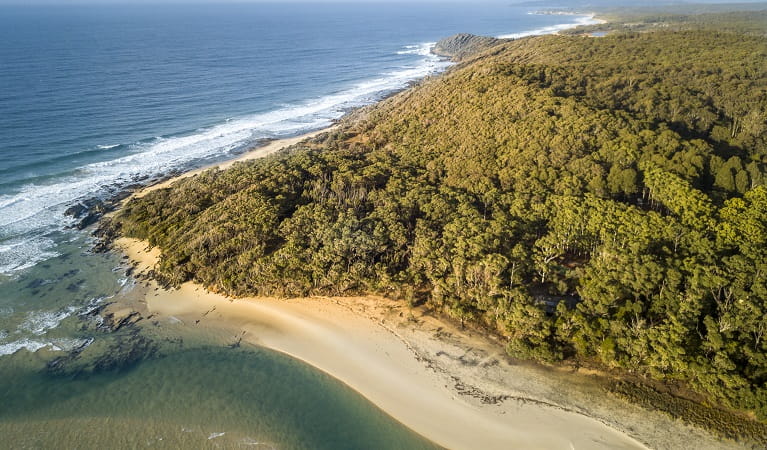Mimosa Rocks National Park
Overview
Located near Bega on the far south coast of NSW, Mimosa Rocks National Park offers a great camping holiday. Visit today to go fishing or birdwatching.
Read more about Mimosa Rocks National Park
Mimosa Rocks National Park offers up show-stopping headland views, beaches and pure lagoons. You’ll be spoilt for choice with lookouts, rainforest pockets and historic sites to explore.
The park takes its name from the Paddle Steamer Mimosa that wrecked in 1863 after running onto rocks at the northern end of the park. The rocks of Mimosa have distinctive castle-like features that are the result of intricate folds, faults and intrusions occurring in the rock. For a view you’ll never forget, head to Bunga Head for sunrise, the rocks look magnificent backed by the pinks of the early morning sky.
You’ll also find plenty of opportunities for fishing, surfing, snorkelling and birdwatching throughout the park and there are great picnic areas to stop for a break. The park’s headlands are great vantage points for whale watching in winter.
It’s a great place to escape to for the day, and if you’d like to stay for longer, there are a range of campgrounds to choose from, including sites with motorhome and camper trailer access.
Please contact the local park office several months in advance if you'd like to plan and book a group activity here including school excursions, wedding ceremonies, sporting or other events.
Local alerts
For the latest updates on fires, closures and other alerts in this area, see https://www.nationalparks.nsw.gov.au/visit-a-park/parks/mimosa-rocks-national-park/local-alerts
Map
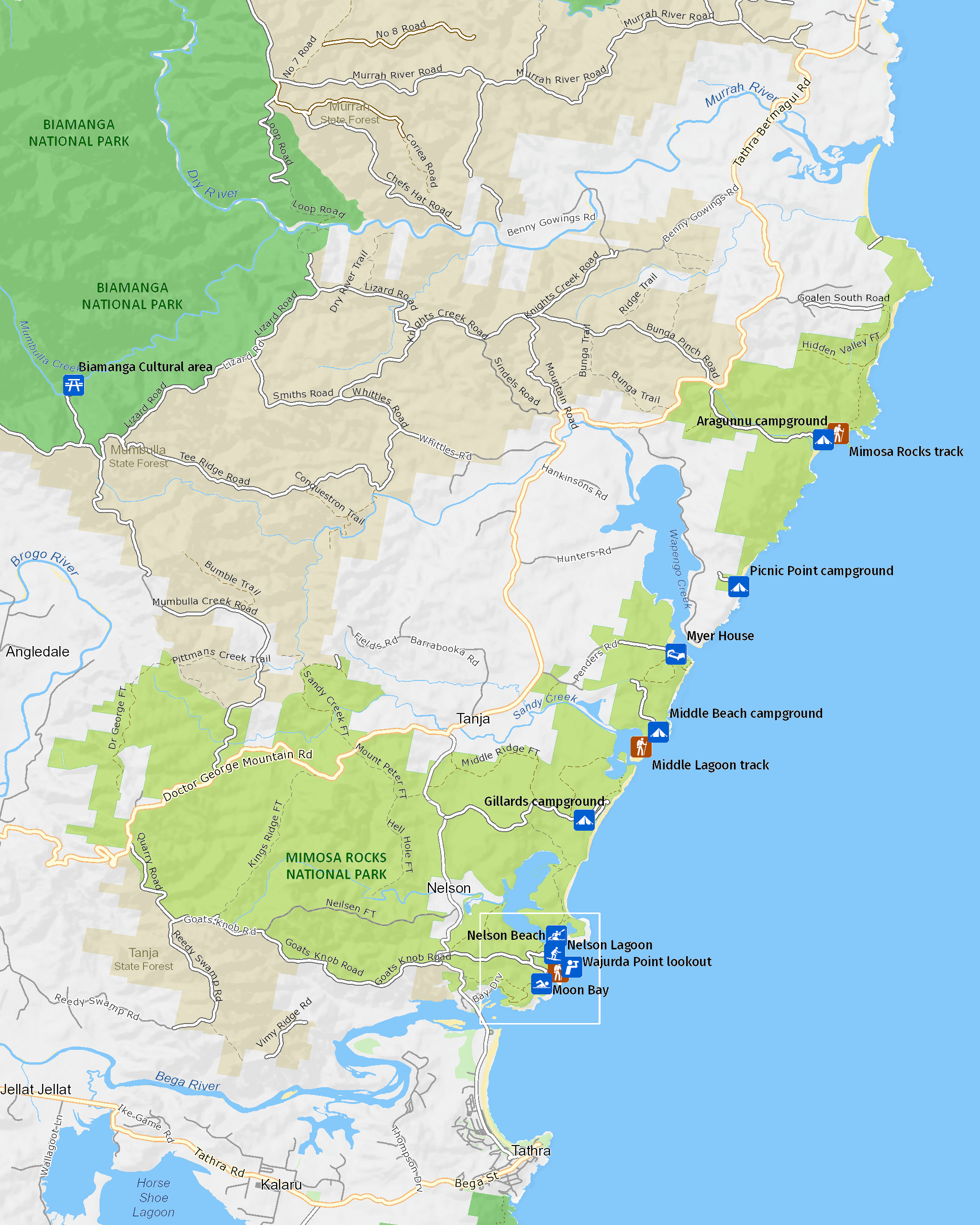
Map
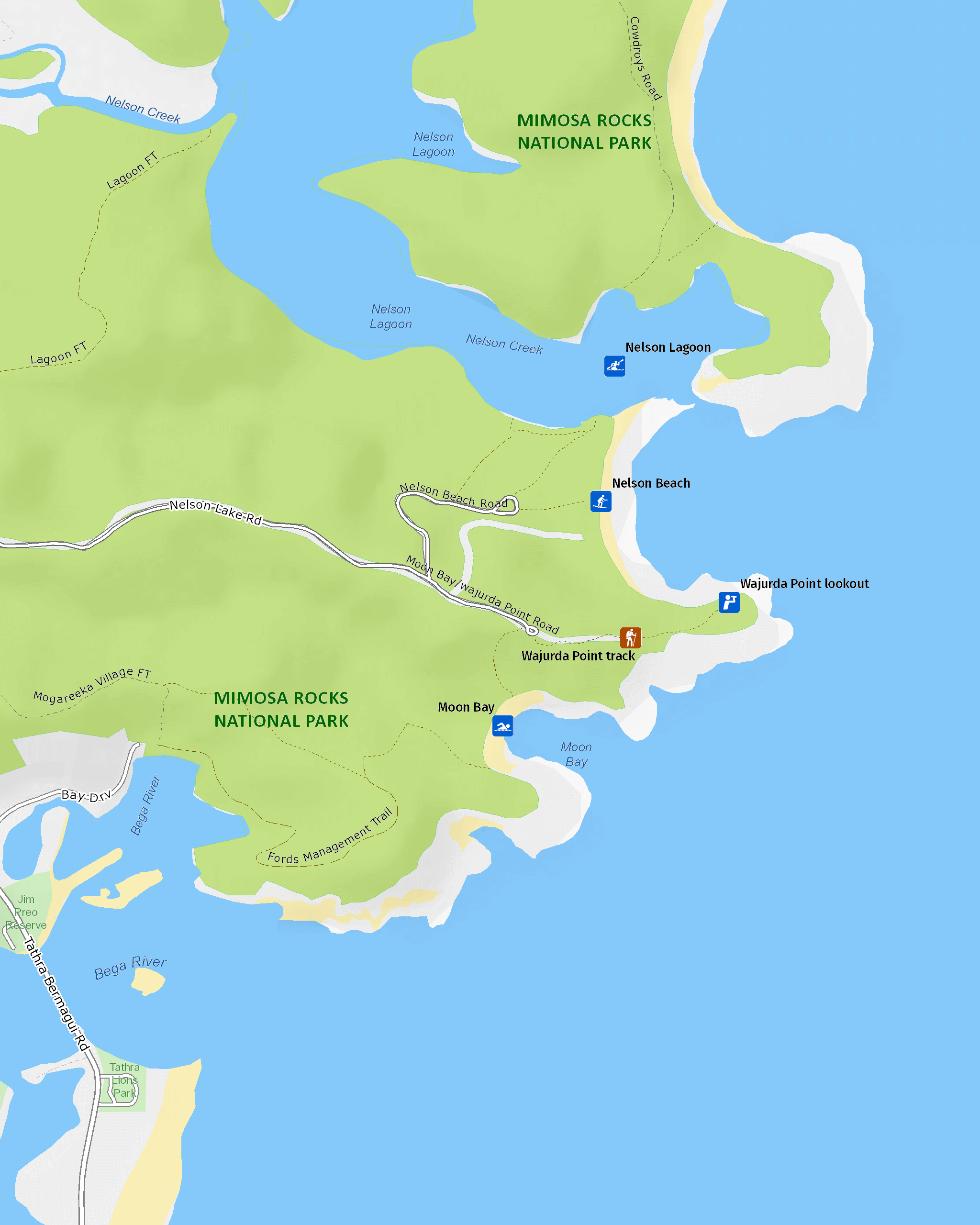
Map legend

Contact
- in the South Coast region
Mimosa Rocks National Park is always open but may have to close at times due to poor weather or fire danger.
-
-
Narooma office
02 4476 0800
Contact hours: Monday to Friday, 9am to 4pm. Office open by appointment only. Closed public holidays. - 10 Graham Street, Narooma NSW 2546
-
Email: npws.eurobodalla@environment.nsw.gov.au
-
Narooma office
Visitor info
All the practical information you need to know about Mimosa Rocks National Park.
Getting there and parking
Get driving directions
- From Bermagui follow the main Tathra-Bermagui Road.
- From Bega, take the Tathra Road off of the Princes Highway at Bega and turn north on the Tathwa - Bermagui Road.
- From Merimbula take Sapphire Coast Drive north to Tathra.
- Side roads from Tathra-Bermagui Road, north of Tathra will take you to all areas of the park.
Parking Show more
- Aragunnu campground See on map
- Gillards campground See on map
- Moon Bay See on map
- Nelson Beach See on map
- Picnic Point campground See on map
- Wajurda Point lookout See on map
Road quality
- Unsealed roads
Vehicle access
- 2WD vehicles
Weather restrictions
- All weather
By bike
Check out the Bicycle information for NSW website for more information.
Best times to visit
There are lots of great things waiting for you in Mimosa Rocks National Park. Here are some of the highlights.
Spring
Head to one of the park's headlands for great whale watching – don't forget your binoculars for up close views.
Summer
A great time for a family camping holiday by the beach, try Aragunnu campground or Gillards campground .
Winter
Keep your eyes on the parks winter-flowering plants, like spotted gums, mugga ironbark and coastal banksia for honeaters and lorikeets.
Facilities
Toilets
Picnic tables
Barbecue facilities
Public phone
Showers
Electric power
Maps and downloads
Prohibited
Pets
Pets and domestic animals (other than certified assistance animals) are not permitted. Find out which regional parks allow dog walking and see the pets in parks policy for more information.
Smoking
NSW national parks are no smoking areas.
Nearby towns
Tathra (5 km)
Tathra is a small coastal township clustered around a historic sea wharf, a popular fishing platform and the only one of its kind remaining on the east coast of Australia.
Bega (23 km)
With its forests, lush pastures and a coastline sculpted into a succession of wonders by the sea, the Sapphire Coast is a perfect holiday destination at any time of the year. Set in a valley at the junction of the Bega and Brogo rivers and surrounded by rich dairy country, Bega is a handsome, historic town that's the rural centre of the Sapphire Coast and gateway to the lush Bega Valley. Visit the Bega Cheese Heritage Centre, housed in a faithful reproduction of the original, tells the story of cheese-making production in the area.
Merimbula (30 km)
The main coastal towns of the Sapphire Coast include Bermagui, Tathra, Merimbula and Eden. This stunning coastline has sparkling beaches and bays, lakes and national parks, all accessible via excellent walking tracks and coastal drives. You'll find beaches just perfect for surfing, swimming and walks.
Bermagui (39 km)
Bermagui is a colourful port, famous for its deep-sea fishing. It's on the estuary of the Bermagui River, close to national parks.
Learn more
Mimosa Rocks National Park is a special place. Here are just some of the reasons why:
Bygone eras
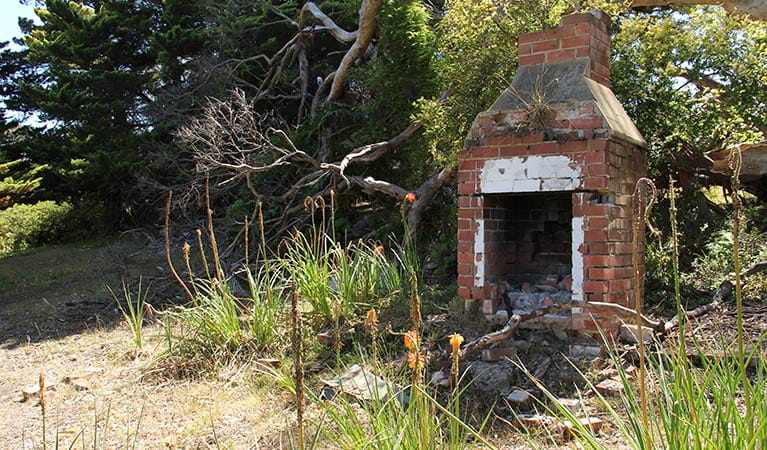
White settlers arrived in the Bega Valley in the 1830s, attracted by its grazing and farming potential, with Bega township being established in 1851. In its earliest years the town traders used Moon Bay as a regional port shipping Timber and sheep products from its sheltered waters. You can still see a log-slide and mooring ring from bygone days, or take a walk to 'Riverview' in the park's south-east, the remains of these historic premises have important associations with the 19th century timber and coastal shipping industries.
- Mimosa Rocks walking track Great for walking with children, the easy Mimosa Rocks walk takes you along a short boardwalk to a lookout. You may spot the Mimosa shipwreck on the rocks below.
- Moon Bay A short and easy walking track descends steeply to the secluded beach at Moon Bay in Mimosa Rocks National Park. Enjoy a picnic on the sand and explore the historic heritage of the area.
Ancient connections
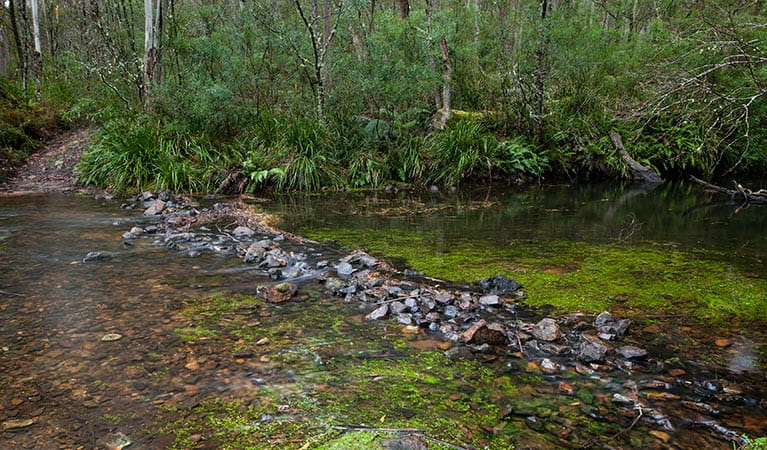
Mimosa Rocks National Park lies within the traditional Country of the Yuin people who have inhabited the region for thousands of years, climbing these headlands, swimming in the rivers and lakes, crossing the sand dunes and walking the beaches. The plants and animals within the park were a source of food, medicine and shelter for the Yuin people and the park's landscape is strongly connected to Dreaming stories. Be sure to take the Mimosa Rocks walk for an insight into the Aboriginal heritage within the park.
- Living Country living culture Join us for Living Country, living culture – a Stage 1 HSIE excursion in Mimosa Rocks National Park. An Aboriginal guide will help students understand the importance of culture and caring for Country.
- Living Country, living culture Join us for Living Country, living culture – a Stage 2 HSIE excursion in Mimosa Rocks National Park. In this cross-curricular program, an Aboriginal guide will help students understand the importance of culture and caring for Country.
- Mimosa Rocks walking track Great for walking with children, the easy Mimosa Rocks walk takes you along a short boardwalk to a lookout. You may spot the Mimosa shipwreck on the rocks below.
Wildlife haven
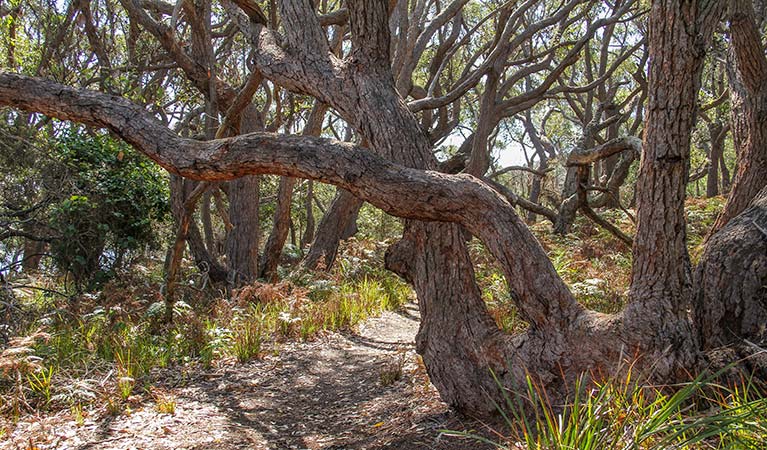
The park provides refuge for koalas, swamp wallabies and ringtail possums, to name a few. Of an evening at Aragunnu campground, you may not see yellow-bellied gliders flitting between trees, but you might be able to hear their distinctive cackling sound that cuts through the silence of the night. At Gillards campground you may well see a long-nosed potoroo. About the size of a rabbit, they look quite similar to a bandicoot, except that they hop in a similar way to a kangaroo. The potoroo is nocturnal, so you are most likely to see them in the evening. The park is an important stop for many migratory birds that nest along the park’s coastline. Look along the beaches and rock platforms – you may see threatened hooded plovers or pied oystercatchers. The bar-tailed godwit stops by briefly in summer during its migration from Alaska to New Zealand. It’s a well deserved stop off as the bar-tailed godwit makes the longest known non-stop flight of any bird and the longest journey without pausing to feed by any animal. Look for them around the park’s lakes and lagoons.
- Forest meets the sea guided walk Experience some of the best coastal views Mimosa Rocks National Park has to offer on this exciting guided walk with Navigate Expeditions.
- Wajurda Point lookout Wajurda Point lookout, in Mimosa Rocks National Park offers coastal and ocean views with seasonal whale watching opportunities.
Plant spectacular
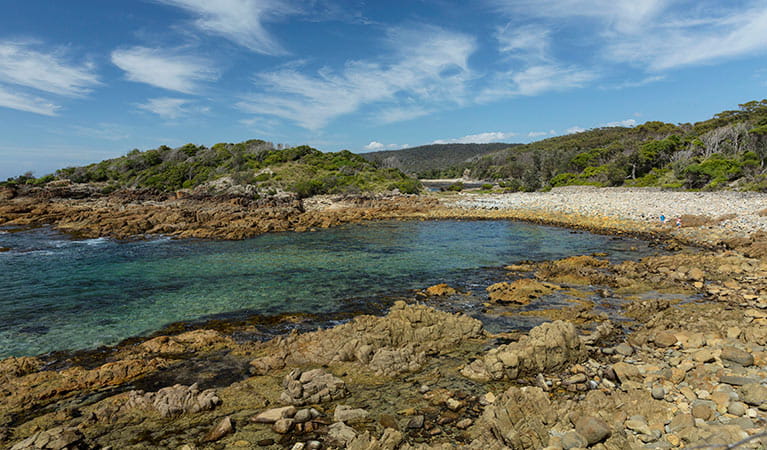
When you’re driving from the south and about to cross the Bega River, you are sure to notice the knife edge boundary of spotted gum, with an understorey of burrawang palms; characteristic vegetation of Mimosa Rocks National Park. When exploring the dunes and cliffs of the park you’ll see coastal banksia, coast wattle and drooping she-oak that can withstand winds and salty air. Check the gullies for the tubular flowers of the endangered chefs hat correa, so called because it’s a similar shape to a chef’s hat.
- Forest meets the sea guided walk Experience some of the best coastal views Mimosa Rocks National Park has to offer on this exciting guided walk with Navigate Expeditions.
- Merimbula guided photography tour Capture Merimbula’s stunning scenery on this unique tour guided by Mark Gray Gallery and Photography Tours. It’s a great way to learn new photography skills while exploring this magical area.
- Mimosa Rocks walking track Great for walking with children, the easy Mimosa Rocks walk takes you along a short boardwalk to a lookout. You may spot the Mimosa shipwreck on the rocks below.
- Moon Bay A short and easy walking track descends steeply to the secluded beach at Moon Bay in Mimosa Rocks National Park. Enjoy a picnic on the sand and explore the historic heritage of the area.
Plants and animals protected in this park
Animals
-
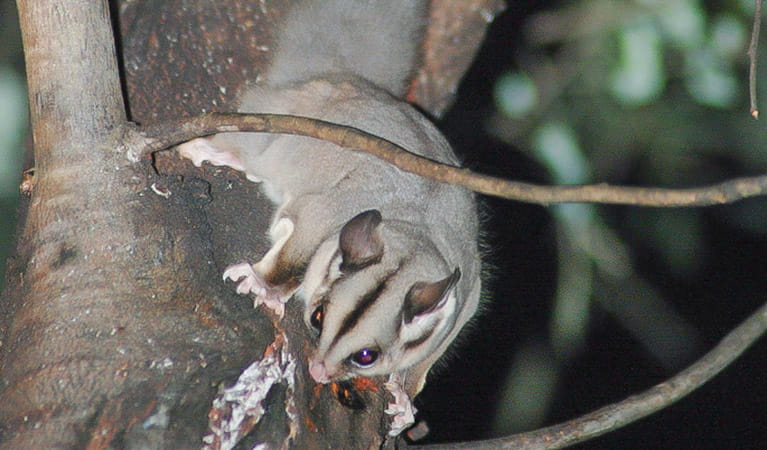
Sugar glider (Petaurus breviceps)
The sugar glider is a tree-dwelling Australian native marsupial, found in tall eucalypt forests and woodlands along eastern NSW. The nocturnal sugar glider feeds on insects and birds, and satisfies its sweet tooth with nectar and pollens.
Plants
-
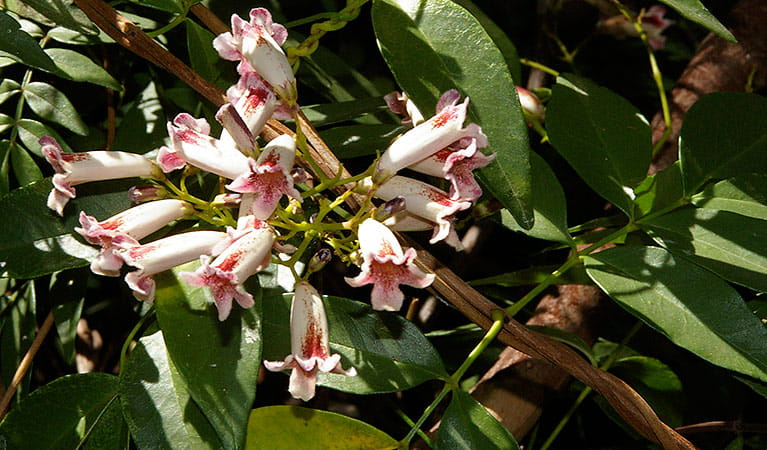
Wonga wonga vine (Pandorea pandorana)
The wonga wonga vine is a widespread vigorous climber usually found along eastern Australia. A variation of the plant occurs in the central desert, where it resembles a sprawling shrub. One of the more common Australian native plants, the wonga wonga vine produces bell-shaped white or yellow flowers in the spring, followed by a large oblong-shaped seed pod.
-
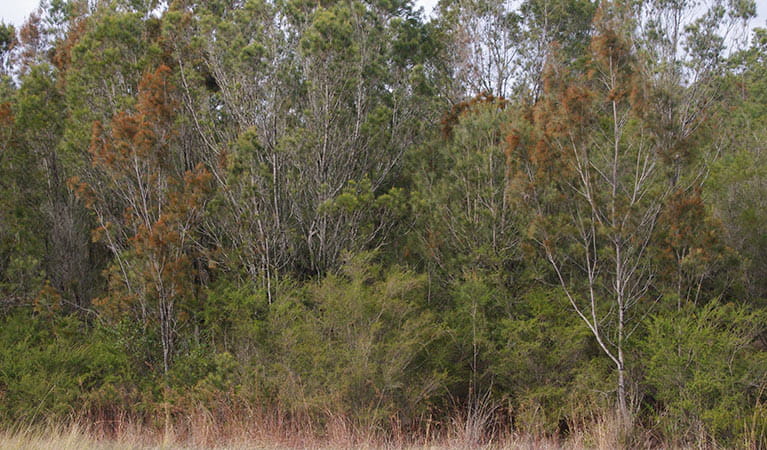
Black sheoak (Allocasuarina littoralis)
The black sheoak is one of a number of casuarina species found across the east coast of Australia and nearby tablelands. Growing to a height of 5-15m, these hardy Australian native plants can survive in poor or sandy soils. The barrel-shaped cone of the black sheoak grows to 10-30mm long.
-
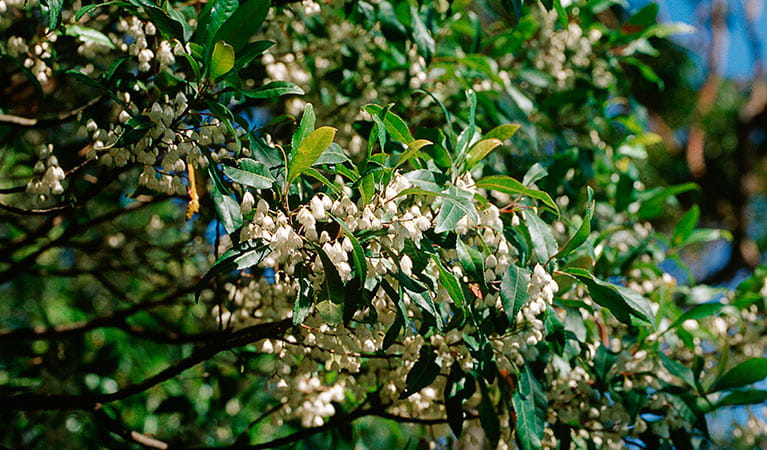
Blueberry ash (Elaeocarpus reticulatus)
The blueberry ash is a rainforest shrub which produces blue olive-shaped berries and spectacular bell-shaped flowers, which often appear on the plant together. It is a tall slender shrub or small tree found in rainforest, tall eucalypt forest and coastal bushland in eastern NSW, south-east Queensland and Victoria.
-
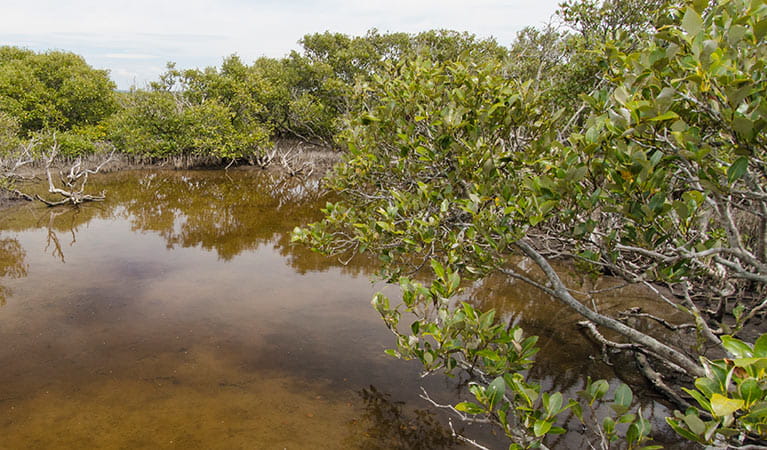
Grey mangrove (Avicennia marina)
Grey mangrove is the most common and widespread mangrove found within intertidal zones across Australia, and throughout the world. Growing to a height of 3-10m, they thrive best in estuaries with a mix of fresh and salt water. They excrete excess salt through their long thick leaves, and absorb oxygen through their aerial root system.
Environments in this park
Education resources (1)
School excursions (3)
- Living Country living culture, Stage 1 (Years 1-2), HSIE
- Living Country, living culture, Stage 3 (Years 5-6), HSIE
- Living Country, living culture, Stage 2 (Years 3-4), HSIE
What we're doing
Mimosa Rocks National Park has management strategies in place to protect and conserve the values of this park. Visit the OEH website for detailed park and fire management documents. Here is just some of the work we’re doing to conserve these values:
Preserving biodiversity
Mimosa Rocks National Park supports efforts to monitor, help recover and secure threatened populations. The area targets pest impacts and works to limit disturbance from recreational users. NPWS is committed to maintaining the park’s biodiversity of flora and fauna. Field studies and concentrated surveying activities are carried out in order to maintain this, and to protect and conserve native wildlife, such as koalas.
Managing weeds, pest animals and other threats
Mimosa Rocks National Park is rich in biodiversity, and pests and weeds can have an impact on this sensitive park value. Pest reduction is a priority to manage species which threaten this reserve, and ongoing risk assessment takes place to identify new and emerging weeds. This plays an important part of the work NPWS does to protect this park for the future.
Developing visitor facilities and experiences
Mimosa Rocks National Park maintains its facilities and infrastructure to ensure optimal visitor experiences. NPWS regularly reviews the park’s amenities, accommodation and recreational offerings to identify areas for improvement or upgrading. The community is consulted on changes to culturally or historically significant assets. NPWS regularly assesses its processes and systems in this park, implementing new ideas and technologies as appropriate.
Conserving our Aboriginal culture
Mimosa Rocks National Park proudly acknowledges its Aboriginal cultural heritage. While working to promote public understanding and appreciation of these values, NPWS ensures the park’s cultural sites are appropriately supported and conserved. NPWS collaborates with local Aboriginal land councils in co-managing park projects, supports cultural tourism initiatives and works with Aboriginal Partnership programs to maintain sufficient protection for cultural heritage sites.
Managing fire
NSW is one of the most bushfire prone areas in the world as a result of our climate, weather systems, vegetation and the rugged terrain. NPWS is committed to maintaining natural and cultural heritage values and minimising the likelihood and impact of bushfires via a strategic program of fire research, fire planning, hazard reduction, highly trained rapid response firefighting crews and community alerts.

